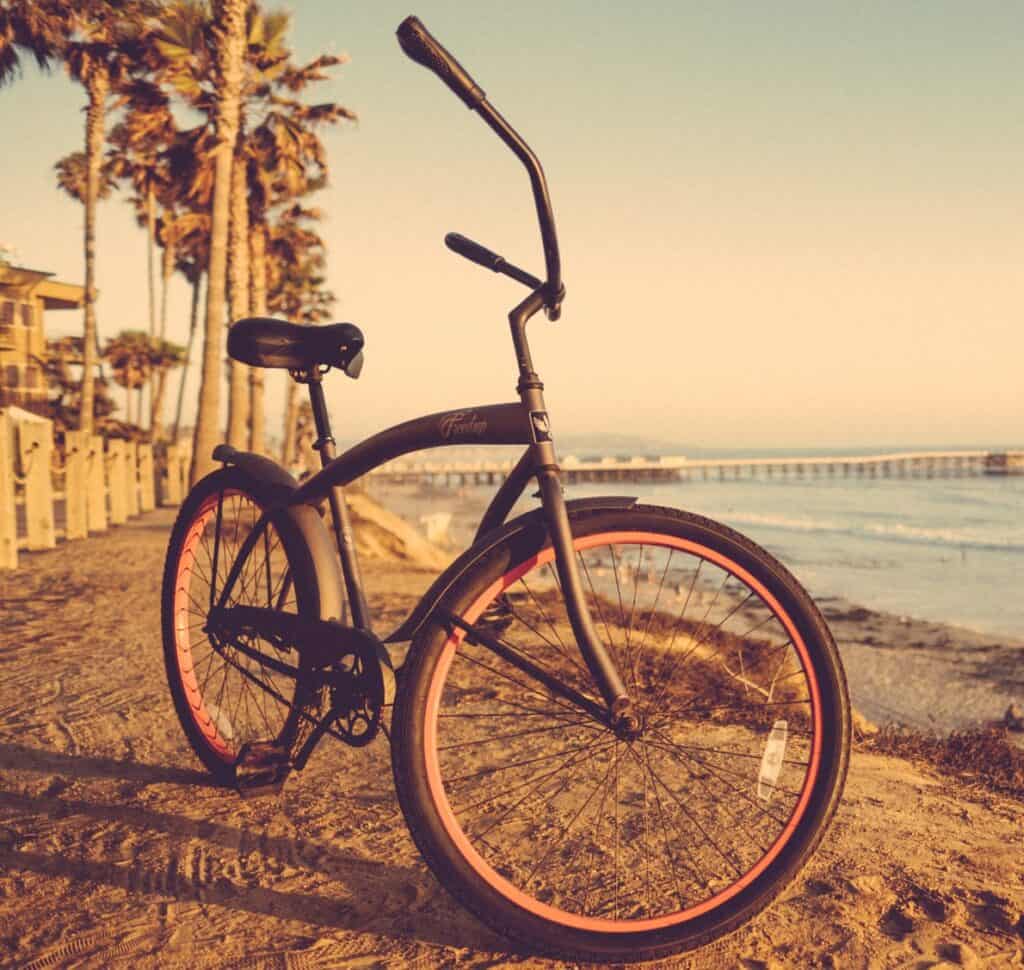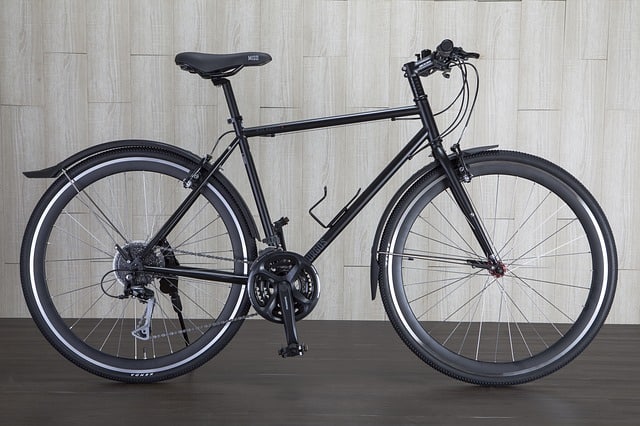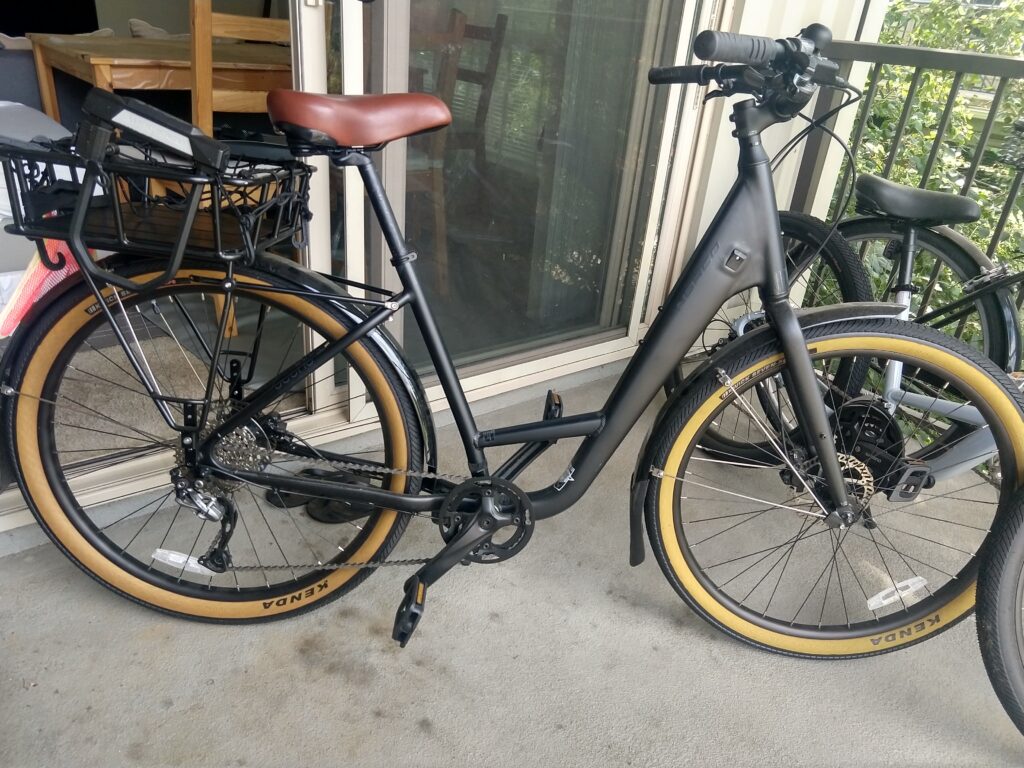Last updated: April 10th, 2024
Hybrids and cruisers are both affordable and easy to find, but they cater to drastically different preferences.
From commuting and errands to riverwalk rambling to occasional trails, I’ve put both styles through the paces over a lifetime of cycling.
Cruiser bikes vs. hybrids in brief
Cruisers are supremely comfortable, smooth to ride, and have a fun retro style. That all comes at the cost of sluggishness and unresponsive handling. Hybrids are livelier and more versatile, but they don’t offer the yacht-like smoothness of a cruiser.
Most riders will enjoy hybrids more, but it’s still worth considering a cruiser if you plan on solely mellow riding on mild terrain.
Posture is the biggest (and least changeable) difference, but there are also technical differences on almost every level.
Before we get into those details, what exactly are we talking about?
A typical cruiser bike

The quintessential beach cruiser features extremely upright posture, wide tires, and simple and low-maintenance parts. These leisure-first bikes aren’t going to win any races, but then again, they’re not meant to.
A representative hybrid bike

Hybrid bikes are named for their combination of road and mountain bike features.
Generally, their road heritage shows up in the form of 700C wheels, slick tires, and fairly high gearing.
From MTBs, you’ll typically find flat bars, disc brakes, and generally sturdier frames.
A halfway point between hybrids and cruisers

Smoother and more relaxed than hybrids, but livelier than cruisers, some models like this Norco Scene 1 split the difference. You’ll generally see fairly upright posture, moderately wide tires (45–50 mm), partially swept-back handlebars, and moderate to wide gearing. Roughly speaking, these middle-ground bikes are as versatile as hybrids, but trade some speed for comfort.
Now that we’re clear on terms, let’s dig into some key comparisons.
Riding posture is the key difference
Cruisers are upright or slightly laid-back for comfort, whereas hybrids lean slightly forward to improve efficiency and handling.
Keep in mind that comfort is relative to distance. Everyone enjoys a few minutes on a cruiser that feels like their favorite reading chair. But 30 or 60 minutes with all your weight directly over the saddle? That may be another story.
Budget models abound (and so do high-end hybrids)
Cruisers skew toward the entry level, so you’ll find them cheaper on average. But for comparable quality, cruisers and hybrids cost roughly the same.
The cheapest hybrids worth buying start at $500–$600. That’ll snag you a trustworthy (if unexciting) classic like the Trek FX 1, Specialized Sirrus 1.0, or Co-op CTY 1.0. If you’d prefer a low-maintenance belt drive, then the Priority Classic Plus and Gotham Edition (read the full comparison here) are also within reach.
Daily commuters, avid fitness riders, or more adventurous types should budget around $1000–$1500 for key upgrades. That price range means hydraulic disc brakes, modern 1x drivetrain with a clutch-equipped derailleur, and generally less weight. With Priority Bicycles, one of my current favorite brands, it’ll even get you the ultimate hassle-free configuration: belt drive, hub gears, and dynamo lighting.
That’s arguably the limit for practical upgrades, but it’s entirely possible to drop three grand on a cutting-edge hybrid with the best of everything.
A representative entry-level cruiser is as little as $300–$400. In most cases, there are two huge caveats: a single speed and a single (coaster) brake. A 3- or 7-speed cruiser with dual brakes, à la Electra Cruiser 3i or 7D, will start around $600. That’s the sort worth buying, in my humble opinion, and its price is in line with similarly equipped hybrids.
As of publishing, around $800 is more or less their price ceiling. Customized show bikes can reach astounding prices—after all, custom chrome work doesn’t come cheap—but as for stock bicycles, the high-end cruiser market barely exists.
Cruiser are much heavier, but it may not matter
Beach cruisers weigh roughly 10 pounds more than entry-level hybrids, and 15 pounds more than high-end models. Difference can be even more extreme, with 20–30 pounds separating decked-out custom cruisers from the lightest carbon-fiber hybrids.
A typical cruiser clocks in around 37–40 lbs. That’s roughly average across the price spectrum. Entry-level hybrids are a comparatively svelte 27–30 lbs, but the lightest are barely over 20.
What accounts for such a huge weight discrepancy? Longer, bulkier cruiser frames (often made of inexpensive hi-ten steel) are the main factor. Classic balloon tires feel silky-smooth on the boardwalk, but contribute another 300–500 grams of rotating mass per wheel. Elongated cruiser handlebars and enormous, butt-cradling saddles also tack on some heft.
But does that make a practical difference?
In daily use, weight matters less than you’d think—or certainly less than big-brand marketing campaigns would have you believe.
However, it depends on what you’re doing (accelerating, coasting, or carrying the bike), where the weight comes from, and how large the whole bike is.
Small, spread-out weight differences are irrelevant to most riders. A couple pounds, evenly distributed throughout a bike, is immaterial. Even larger differences slip into the background once you’re up to speed.
Enormous weight differences—such as the 10+ lbs between a cruiser and a hybrid—are in fact noticeable, especially when you’re accelerating or perhaps tackling a nasty climb. That’s doubly true of rotating weight (i.e., tires and wheels), which needs to accelerate in two different planes of motion.
Cruisers’ weight is less of a liability in the slow, steady riding scenarios they’re designed for. Likewise, a hybrid’s sleekness isn’t particularly helpful on the boardwalk. But when hills and traffic lights enter the picture, I’ll take the hybrid every time.
Lastly, there’s the question of portability. A lighter, shorter-wheelbase hybrid is less unpleasant to carry up stairs or load onto the rack of a bus.
Most cruisers stick to basic components
For beach cruisers, simplicity and affordability trump performance. Hybrids come in a far wider range of prices and spec levels, although no-nonsense budget models are certainly available.
Cockpit
The signature cruiser feel comes from high-rise, long-reach handlebars. The broad, elevated hand position keeps you bolt-upright or even slightly reclined. It lets you take in the sights without a hint of neck strain, but fights any effort to hammer out a sprint or steep climb.

Hybrid riding positions vary. Similar to a typical MTB, most use flat or low-rise handlebars. They create a slight forward lean that reduces wind resistance, increases glute use for pedaling power, and improves handling by balancing front/rear weight distribution.

Saddles also differ since the right one depends on posture. On cruisers, they’re shorter and broader to support more of the rider’s weight. On hybrids, they’re longer and narrower to avoid interference with your thighs.
Gearing
Beach cruiser gearing suits easy riding on flat routes. Hybrids’ wider gearing suits a wider range of terrain, but is overkill for simply cruising around.
A typical cruiser has 1 or 3 speeds. You’ll occasionally see 7+ speeds, but wider gearing is rare. The combination of limited gearing with inefficient riding posture makes climbing especially difficult on most cruisers. Then again, cruisers aren’t intended for putting the pedal to the metal, so that’s not a shortcoming per se.
Hybrids have wider gearing to suit climbs and descents. Budget models typically use double or triple chainrings with an 8- or 9-speed derailleur, for 16–27 gears in total. Many higher-end models use a single chainring (a.k.a. 1x/”one-by”) and a wide-range 10- or 11-speed derailleur. Whether 1x or 2x, the overall gear range is similar: they differ primarily in the size of steps between gears, not necessarily in the minimum or maximum gears themselves.
Brakes
At lower prices, rim brakes (specifically V-brakes) prevail on both styles. That’s not a bad thing, since they work terrifically with proper tuning. But unlike (most) cruisers, many hybrids opt for discs, making them the better choice for fast riding, heavy loads, or foul weather.
Virtually all cruisers use coaster or rim brakes for simplicity and cost reduction. Some of the very cheapest have only a rear coaster brake, which limits their use to low speeds (under ~10 mph) in traffic-free areas. Safer (and perhaps more common) alternatives are dual rim brakes or a rear coaster plus front rim brake. Disc-equipped cruisers remain rare, since high-performance brakes make little sense on the definitive leisure bike.
Budget hybrids generally use V-brakes. When properly adjusted, they’re terrific in dry weather and may outperform inexpensive mechanical disc brakes. In the mid-range and above, nearly all hybrids have disc brakes for more power and better wet-weather performance.
Wheels & tires
An average cruiser has fairly fat tires (2″ and up) on medium-diameter wheels (often 26″). Most hybrids use road-bike-size wheels—that’s 700C (29″) or sometimes 650B (27.5″)—with tires typically around 1.4″–1.6″.
Cruisers’ burlier rims and wider tires add some rotating weight, but offer a silky ride over pavement and well-maintained dirt or gravel. Hybrid wheels and tires don’t provide that same floating smoothness, but they do accelerate faster (less mass) and preserve more momentum (less rolling resistance).
Frames
In both geometry and looks, the difference between hybrid vs. cruiser bike frames is night and day.
A classic cruiser frame has graceful (if superfluous) arcs that emulate early motorcycles. Many modern cruiser frames have simplified their shapes, but most retain at least a nod toward their heritage.
Less obvious but more impactful is their slack and elongated geometry. Head tube and seat tube angles are relaxed, for steady steering and easy reach to the ground. They’re complemented by a long wheelbase that maximizes smoothness and stability.
Most hybrid frames are variations of the tried-and-true diamond frame design we all recognize from road and mountain bikes. You’ll also see low-step variations, often called step-through, mixte, or women’s (although many men ride them) depending on just how low the top tube lies.
Geometry varies, but usually strikes a nice balance between lethargic cruisers and lively but sometimes twitchy road bikes.
Here’s what’s right for you
If you value a comfy, affordable bike for mostly short rides, and efficiency isn’t a priority, then cruisers are a good starting point.
They suit that scenario perfectly, but aren’t conducive to much else.
A hybrid is a better choice for all other uses, including any non-trivial hills.
As briefly mentioned up top, many bikes fall in the sweet spot between cruisers and hybrids. My personal favorite (and former daily commuter) is the Norco Scene, followed closely by the Specialized Roll, Marin Larkspur, and Trek Verve (a more upright counterpart to the FX as compared here).
If you value comfort, still want a bit of get-up-and-go, and plan on tackling some hills, then those belong on your shortlist!
